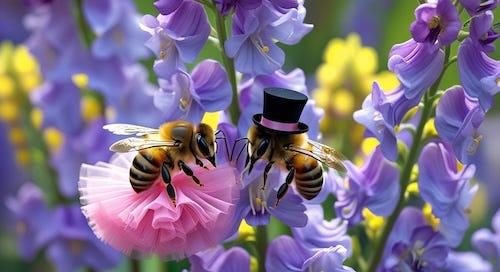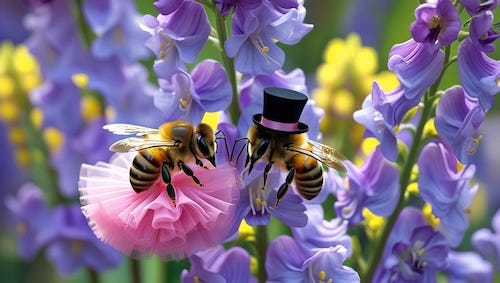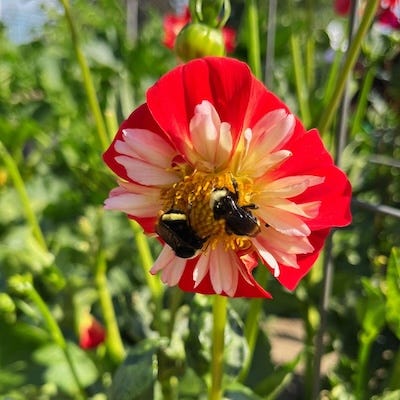Hi there and welcome to Roots! I'm so glad you're here. If you're enjoying what you're reading so far and haven’t subscribed yet, please click that button:
And if you like this post, please tap that heart button ❤️ and leave a comment as that helps the algorithm push this content out to more like-minded souls who might enjoy it. Thank you for being here!
Did you know girl bees wear tutus and boy bees wear top hats?
I’ve always been an outdoor person. If there is something to do outside, why stay inside?
So when my husband and I bought our “forever” home in Denver, we made sure it came with a big yard ready for planting. With just under one-third acre, the backyard was a sight to behold. We dug in and started planting.
We created a tiny oasis just off the back patio. A place we could bring our dinner out each evening and share time as a family.
The funny thing is, our daughter wasn’t having any of it. To say she was afraid would be an understatement. She’d scream. She’d run. She’d cry at the sight of a bee.
Exasperated, I remember one night throwing my arms up in defeat, and telling my then-seven-year-old, “Fine, just carry your plate in and eat inside.” She did.
I tried to coax her back outside. It didn’t work.
So my husband and I tried something. My husband was a part of a networking group with thirty or so members. One of them was a therapist, a hypnotist, who said he could help her get over her fear.
We told her about him … and she wanted nothing to do with it. But we were worried about her future, fearing that she would be afraid of spending time outside. We signed her up, went with her, and watched in amazement.
Our seven-year-old sat there, pouting. We thought, “This isn’t going to work.” But he spoke to her softly, hypnotically, and there she went. He told her all about girl bees wearing tutus and boy bees wearing top hats. “When you see a bee, you have to sit quietly, watching, to determine what they’re wearing. Nothing to be afraid of - you just have to let them carry out their quiet dance.”
It worked.
She didn’t run around chasing them, trying to see what they wore. Instead, she sat at the table quietly when they buzzed by, intently looking at them as they did their thing.
Today, she gardens. She volunteers at a farm. She spends a lot of her time outdoors …
We still laugh in amazement at how that all worked. And I’m (she, we) are all grateful.
We Cannot Survive Without Bees
Urbanites rarely think of the job bees do. Yet without them, we wouldn’t eat.
Around 75 percent of the world’s flowering plants and 35 percent of crops rely on animal pollinators to reproduce. They are essential for the fruits and vegetables you eat. They’re also necessary for so many other raw materials we use, like spices, soybeans, medicines, and even fabric.
There are over 4,000 species of native wild bees in the US. Honey bees alone contribute $5.4 billion to the US economy.
It’s easy to walk through the market, picking up your favorite fruits and veggies, without thinking about where they come from. It takes healthy soil, high-quality seeds, nutrients, water, and plenty of sunshine in order to flourish and produce fruit. And, of course, the bees. Bees dance across a flower, picking up grains of pollen from the male anther of a flower, then transferring it to the female stigma of the flower.
Around 35 percent of our food crops depend on this process. If you love juicy apples, sweet strawberries, or creamy avocados, you can thank a bee for their contribution.
Here’s the scary part: If pollinators disappear completely, it’s estimated that crop production could decline as much as 8 percent or more. Yes, that could cause food insecurity. There are so many challenges facing the species, from habitat loss to temperature and weather changes.
Whether you’ve thought about this problem before or not, there are simple things you can do to help protect them. (It helps you continue to have the yummy food you’ve come to love!)
What You Can Do To Protect The Bees (And Other Pollinators Too)
Eat More Pollinator-Friendly Foods
Here’s the good news for plant-based eating … When you eat a wide variety of plants, you’re likely helping the bee population grow. Pollinators - especially honey bees - contribute to one out of every three bites of food you put on your plate.
When you increase demand for bee-friendly foods, it means farmers will plant more of what’s in demand. That provides more “food” for the bees, giving them reason to increase their population. Yep, circle of life!
Think of that when you select what to eat. Tomatoes are an incredible source for bumble bees. Strawberries are well-loved by bees. Cranberries are pollinated by over 400 bee species. Even cashews wouldn’t be without bees. 🐝
Support a Bee Habitat
What’s the main reason bees are dying off? Habitat loss. As we build more concrete jungles and things to support that lifestyle, it takes away from all the goodness that increases bee habitats. So do something about it. Get out into nature, and find a way to contribute to it.
Replace lawns with a native garden. Increase wildflower meadows. If you don’t have much space, you can plant bee-friendly planters and window boxes. My home has a small deck out front and a small patio out back. I maximize the appeal by filling it with as many flowers as I can.
You can also find ways to learn more about bees in your area. My community garden is a valuable resource. They hold all kinds of classes, including one on mason bees coming up soon. Do a quick search in your area - your local nursery is a great resource. Or look for places like The Bee Conservancy to learn even more about these tiny creatures.
Stop With The Chemicals
Synthetic pesticides, herbicides, and other agrochemicals can and do harm bees. They can and do harm people too. We’re only starting to make people aware of the damage we’ve caused these past few decades with everything we’ve been applying to the fields.
A garden can thrive without these harmful chemicals. If you haven’t seen The Biggest Little Farm, I highly encourage you to take a couple hours and watch it. If you happen to be in California, they offer everything from farmer’s markets to tours.
You might also wish to learn more about regenerative farming. I have watched many videos by co-founder Dr Zach Bush. His message resonates with me deeply. Want to be inspired? Read An Ode To The Honey Bee.
Create a More Effective Gardening Practice
Those leaf blowers that supposedly keep our yards looking nice are actually destroying habitats. Those powerful blasts of air can reach a velocity of up to 200 mph from a one-foot distance. And a lot of helpful bees nest in the ground, which means they receive that blast full-force, and many of them can’t survive.
Yes, it’s time to ban them. Return to a more natural living space, and you won’t have to worry about blowing the grass clippings away. Leave fallen leaves, and it’s a perfect place to nest.
This is where it pays to learn the difference between helpful bees and more aggressive wasps and yellowjackets. If you do want to pick up fallen leaves, pull out a rake and a broom, which are much more helpful to the environment.
And forgo mulch. It’s simply a modern-day aesthetic to make the landscaping “look” clean. (It’s what we’ve been trained to think, so we can easily change.)
Okay, time to buzz back to the great outdoors. Haha! 🐝
p.s. Did you like this message? It would mean a lot to me if you’d press the ❤️ below if you liked it, left a comment 💬, or shared it with a friend. I’m trying to grow this publication, and I depend on people like you to do so!
And if you’re new here, Welcome! 💐 I’d love to start sharing my message with you if you’re interested in all things plant-powered, proaging, or finding kitchen joy. Subscribe … and then explore my entire archive! Glad to share with you! 🙋🏼♀️











